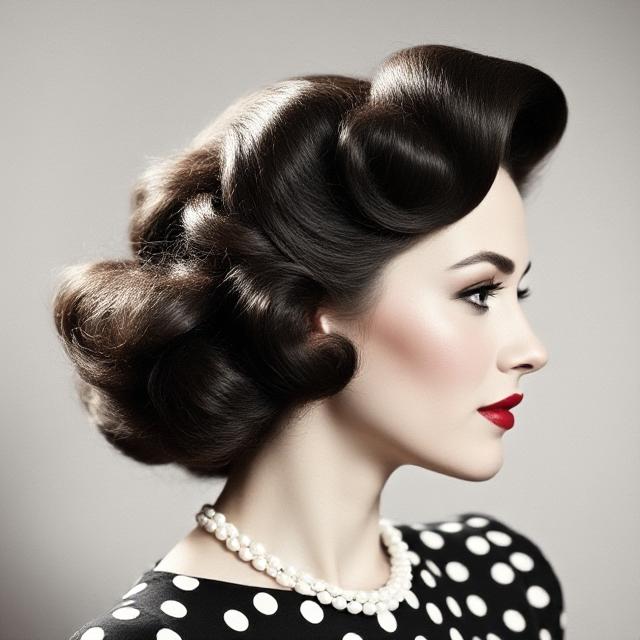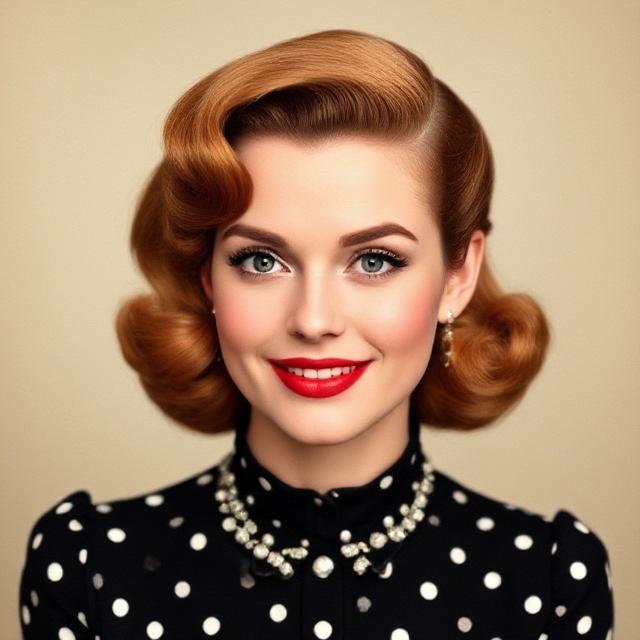The 1950s marked a golden era of glamour and refinement, a time when hair was as much a statement of identity as it was a reflection of Hollywood-inspired dreams. Post-war optimism infused the beauty world with a fresh wave of creativity, leading to the birth of styles that embodied grace, sophistication, and meticulous styling. From the sultry curls of the silver screen sirens to the polished, sculpted updos of suburban housewives, 1950s hair was the pinnacle of classic elegance. This era celebrated femininity in all its forms, with looks that were structured, romantic, and undeniably iconic. Here are 10 legendary 1950s hair looks that not only defined a decade but continue to inspire modern interpretations of timeless beauty.
1. The Poodle Cut
The poodle cut, popularized by stars like Lucille Ball, became a hallmark of the early 1950s. This ultra-curly style hugged the head and was often worn short, giving it a tidy, bouffant appearance. Women with naturally curly or permed hair found this look both manageable and stylish, as it emphasized volume while remaining controlled. The name came from its resemblance to the clipped curls of a well-groomed poodle. Achieving this look required careful curling and a strong setting lotion or mousse to maintain shape throughout the day. What made the poodle cut so attractive was its blend of spunk and sophistication—it was playful yet polished. It suited petite faces and added energy to a woman’s appearance. This style was often accessorized with decorative pins, bows, or small flowers to enhance its flirty charm. While its popularity eventually gave way to longer styles, the poodle cut remains a symbol of early ’50s sass and flair. Its influence can still be spotted in vintage-inspired fashion scenes today, especially among fans of rockabilly or pin-up aesthetics.

2. The Italian Cut
The Italian cut was a sultry, tousled alternative to the more rigid hairstyles of the era. Inspired by European film stars like Gina Lollobrigida and Sophia Loren, this look embraced volume, texture, and a sense of sensual ease. Unlike the structured poodle cut, the Italian cut allowed hair to fall in soft waves or controlled curls that framed the face and highlighted the cheekbones. Typically worn shoulder-length or just above, it gave the impression of effortless beauty, though it still required a strategic mix of rollers, teasing, and setting sprays. The secret was in its artful messiness—sexy without being unkempt. It was the embodiment of continental charm, offering an exotic allure that contrasted sharply with the more conservative American styles. The Italian cut empowered women to express a bolder femininity and was often paired with cat-eye makeup and fitted dresses. It suited confident personalities and has endured as a go-to retro look for women wanting to channel a bit of Mediterranean mystique. Its legacy lives on in red carpet waves and vintage bombshell makeovers.
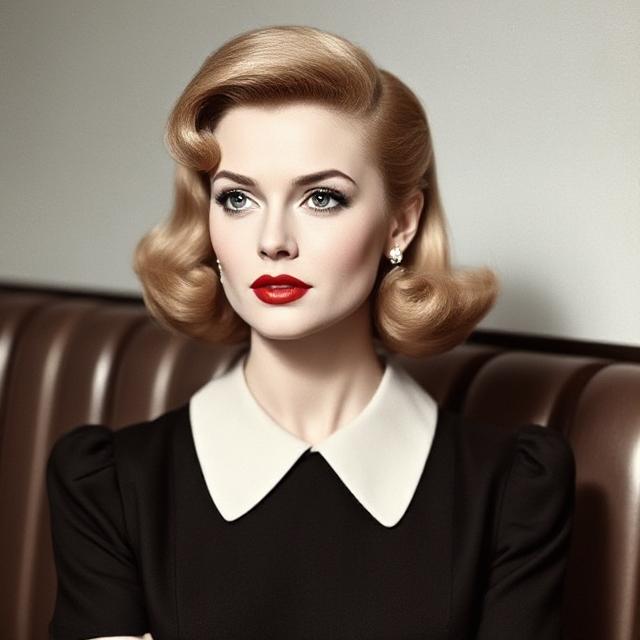
3. Victory Rolls
Though they rose to prominence during the 1940s, victory rolls carried their iconic presence into the early 1950s, especially for women who admired retro military-era glamour. These voluminous rolls, often styled on the top or sides of the head, were both a statement of strength and beauty. Originally symbolizing patriotism during WWII, by the ’50s, they had morphed into a theatrical expression of vintage elegance. Creating victory rolls involved meticulous sectioning, backcombing, and rolling hair into large, dramatic shapes, then securing them with bobby pins and hair spray. They could be symmetrical or asymmetrical depending on preference. This style required patience but delivered a bold and unforgettable look. Victory rolls complemented various face shapes and allowed for creativity—some women paired them with ponytails, while others added floral accents or netted veils. The look worked especially well for formal events, retro parties, or as part of a pin-up ensemble. Today, victory rolls are a favorite among vintage enthusiasts, burlesque performers, and brides looking for a hairstyle steeped in nostalgic charm and undeniable drama.
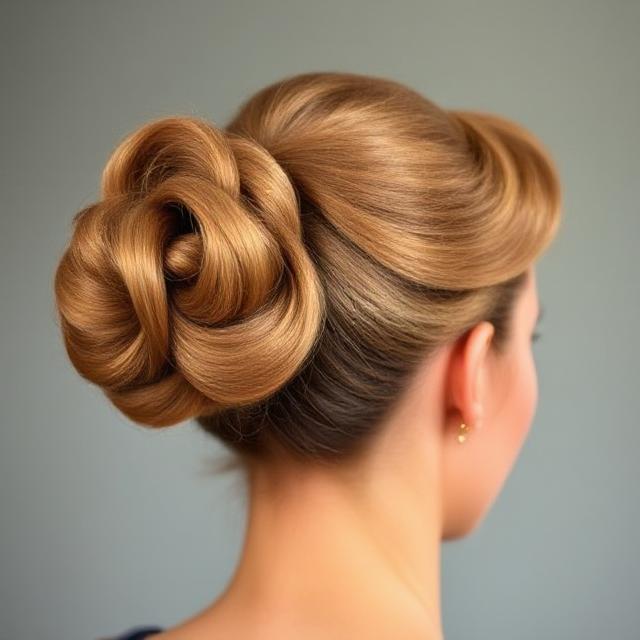
4. The Beehive
The beehive emerged in the late 1950s and quickly became one of the most distinctive hairstyles of the century. Towering above the head in a cone-like shape, this voluminous updo required intense teasing, lots of hairspray, and serious commitment. Created by Chicago-based hairstylist Margaret Vinci Heldt, the beehive represented modernity and the space-age spirit of the era. It gave women height, elegance, and an almost regal silhouette. Achieving the beehive began with backcombing the crown of the hair and shaping it with a padded base or cushion to ensure structure, followed by smoothing the outer layer for a sleek finish. Hair was often lacquered to hold its height for hours, and accessories like headbands, pearls, or clips added personality. Though the beehive reached its peak in the early ’60s, its roots (quite literally) lie in the late ’50s fashion revolution. It embodied power and prestige, standing tall as a beacon of feminine confidence. Even today, the beehive endures on stages and runways, evoking a sense of retro drama and sky-high elegance.
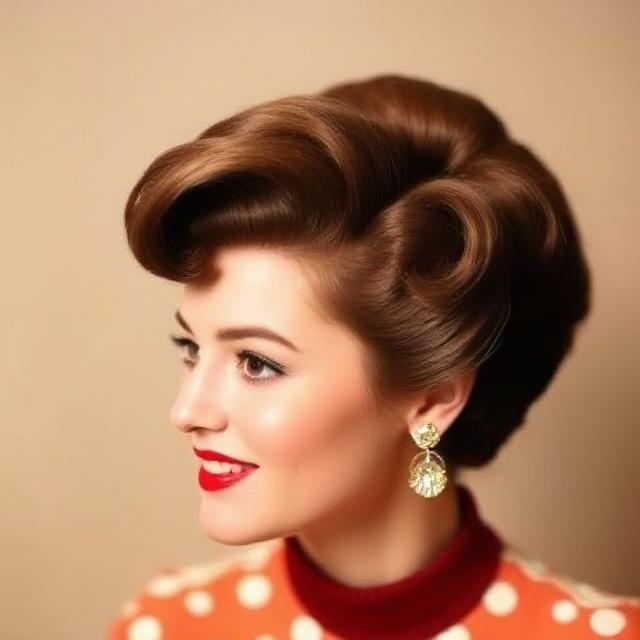
5. The Pageboy
Refined, smooth, and undeniably chic, the pageboy was a modern woman’s dream hairstyle. Popularized by actress Bettie Page and seen across fashion magazines, the style featured straight hair that curled under neatly at the ends, often accompanied by short bangs. The clean lines of the pageboy mirrored the rising popularity of minimalist fashion and made it easy to maintain with the help of heated rollers or curling irons. Women loved the way it framed the face without demanding too much volume or effort. It worked exceptionally well for medium to short lengths and was adaptable—some added side parts, while others wore it with dramatic eyeliner and red lipstick for a fierce, feminine look. The pageboy became synonymous with sleek rebellion; it had an edge without losing its ladylike refinement. This hairstyle carried a cool-girl attitude that contrasted the bouffant-heavy looks of the time. Today, the pageboy finds its echo in mod haircuts and modern blunt bobs, proving that its structured simplicity has never truly gone out of style.
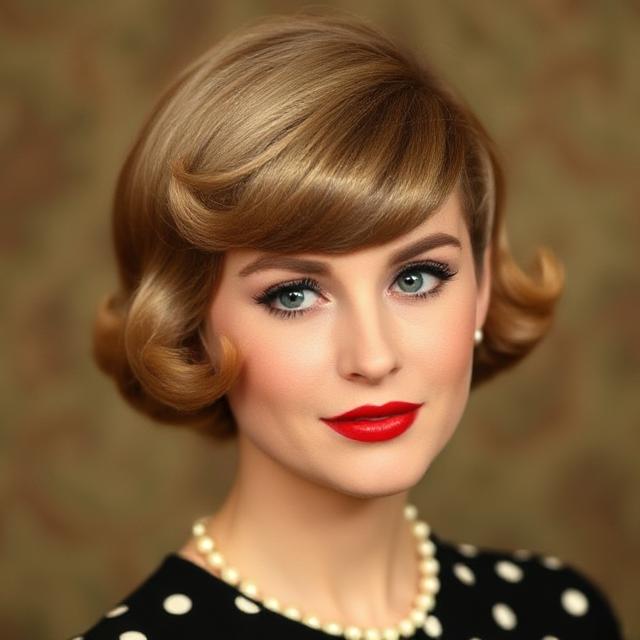
6. The Bouffant
The bouffant was a crown of volume that reigned over the late 1950s and early ’60s. With its cloud-like height and ultra-feminine presence, it became a signature of First Ladies, debutantes, and glamorous film stars alike. This style involved layering the hair, teasing the crown, and smoothing it into a rounded, puffed shape that emphasized height and symmetry. Women would use padding and hairpieces to achieve greater volume and sprayed each layer liberally with hairspray to hold its shape. The bouffant could be paired with a half-up style, worn with cascading curls, or even sculpted into a refined updo. It was as versatile as it was dramatic. Often accessorized with headbands, ribbons, or jeweled combs, it offered an air of sophistication and maturity. This hairstyle required dedication and frequent salon visits, but it gave women a sense of polish that aligned with the decade’s ideals of ladylike perfection. The bouffant continues to inspire red carpet hair, bridal styles, and editorial fashion spreads, where its timeless volume still speaks volumes.
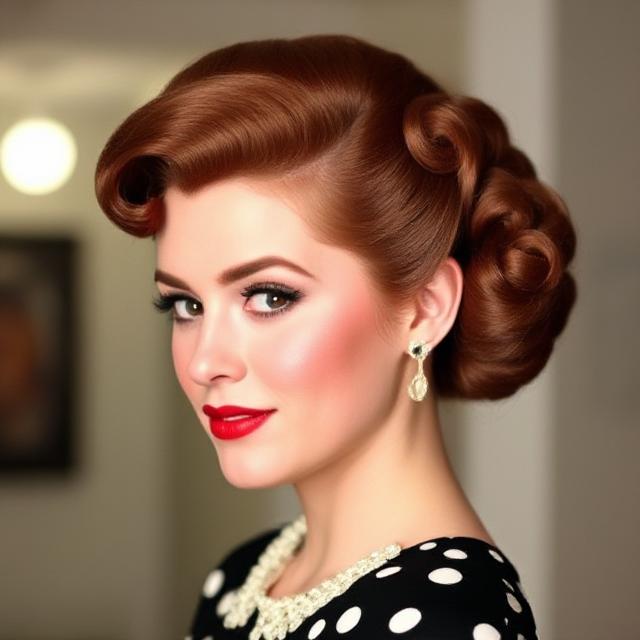
7. The Marilyn Monroe Curls
No list of 1950s hairstyles would be complete without Marilyn Monroe’s signature platinum curls. Her short, layered bob styled in soft, sculpted waves became an emblem of sex appeal and Old Hollywood glamour. These curls were typically set using pin curls or hot rollers, then brushed out gently to form rounded, face-framing waves. The result was a look that was both polished and touchable, sultry yet approachable. Marilyn’s curls complemented her expressive features and exuded confidence without trying too hard. Women across America and beyond copied the style, bleaching their hair and investing in professional stylists to mimic the star’s appeal. This look worked especially well with strapless dresses and fur stoles, enhancing the allure of the neckline and shoulders. While easy to admire, the curls required regular maintenance, from precise cuts to frequent touch-ups. Today, Marilyn’s curls remain a go-to for those seeking vintage bombshell glam, whether for red carpet events or retro-themed parties. It’s a look that has aged as gracefully as the icon herself.
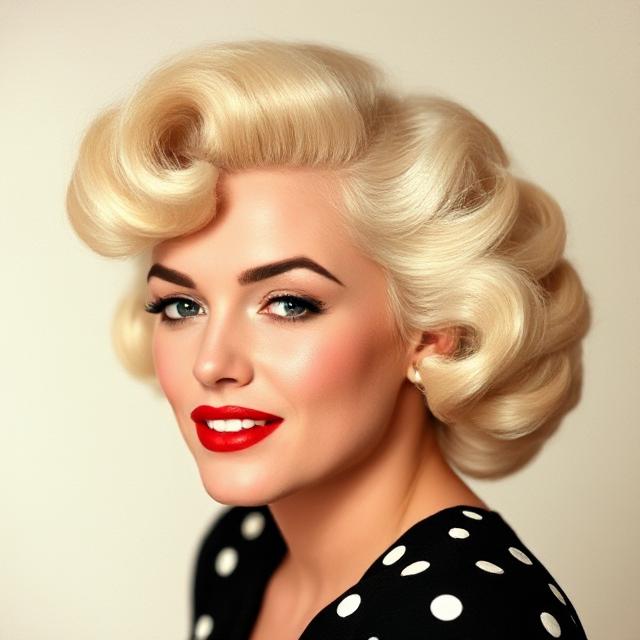
8. The Pompadour
Borrowed from 18th-century French fashion and revived with a modern twist, the pompadour became a dramatic choice for stylish women of the ’50s. Characterized by its high-volume front, the pompadour was often styled with the rest of the hair pulled back into a bun, ponytail, or roll. It drew attention to the face and forehead, creating an illusion of elongation and confidence. Stars like Connie Francis and Wanda Jackson popularized the style in both music and film circles. The pompadour took skill to master—it began with teasing the front section of the hair, then rolling it backward or forward into a voluminous mound, secured tightly with pins and product. While some versions were sleek and smooth, others embraced a more rockabilly edge with textured sides and accessories like scarves or barrettes. The pompadour offered a bold alternative to the more demure hairstyles of the day, making it a favorite among rebellious spirits and fashion-forward thinkers. Its legacy endures in both vintage and punk circles today, where attitude and height go hand in hand.
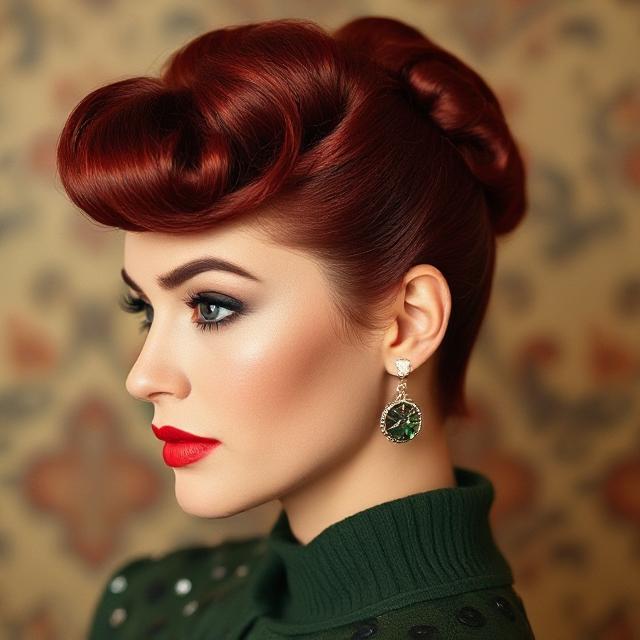
9. The Pixie Cut
A radical departure from the voluminous trends of the 1950s, the pixie cut carved out its place as a daring declaration of individuality. Audiences were stunned when Audrey Hepburn debuted her cropped style in Roman Holiday—a soft, boyish look that still radiated femininity and grace. The pixie cut featured close-cropped sides, subtle volume at the crown, and often included wispy bangs or side-swept layers to soften the edges. Unlike the structured waves or elaborate updos of the time, the pixie was refreshingly minimalist and required very little maintenance. Its androgynous flair challenged conventional beauty standards and opened the door for women to redefine elegance on their own terms. It worked best on women with delicate features and confident demeanors, as it exposed the neck, ears, and jawline. Though not as mainstream during its time, the pixie cut left an indelible mark on fashion history. Today, it’s embraced by modern muses from film, fashion, and music, echoing that same spirit of fearless beauty and refined rebellion.
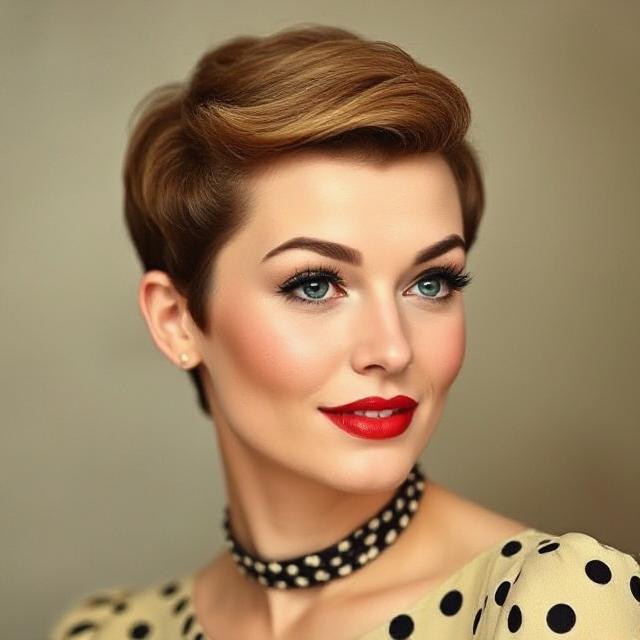
10. The Gibson Roll Revival
While the Gibson roll originated in the early 20th century, it made a quiet yet elegant comeback during the 1950s among women who preferred romantic, vintage flair. This hairstyle involved rolling the hair into a tucked-up chignon at the nape of the neck, often accompanied by soft waves or delicate curls at the front. It was understated, graceful, and perfect for both daytime refinement and evening sophistication. To create the look, women used a hair “rat” or rolled padding to give volume to the tucked-in shape. It framed the neck beautifully and provided a flattering alternative to the more towering styles of the time. The Gibson roll was especially favored for weddings, dances, and formal occasions, giving off an aura of old-world class. Paired with pearls and satin gowns, the look became an emblem of retro romance. While it didn’t dominate mainstream trends, its quiet persistence throughout the decade is a testament to its enduring appeal. Today, the Gibson roll continues to grace bridal magazines and vintage-themed events, offering a timeless option for those seeking poised elegance.
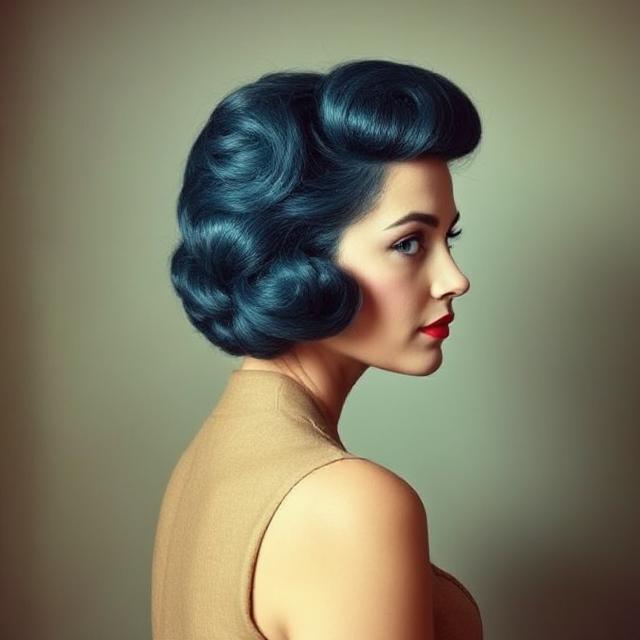
The hairstyles of the 1950s represent far more than mere trends—they are living symbols of a cultural shift, an era where femininity was celebrated with poise, flair, and creative discipline. Each look carried its own statement, from the daring pixie to the voluptuous bouffant, reflecting the changing roles and aspirations of women in post-war society. Whether emulating a Hollywood starlet, a European beauty, or a confident girl-next-door, women of the ’50s knew how to turn hair into an art form. These legendary styles continue to inspire today, reminding us that elegance never truly goes out of fashion.
